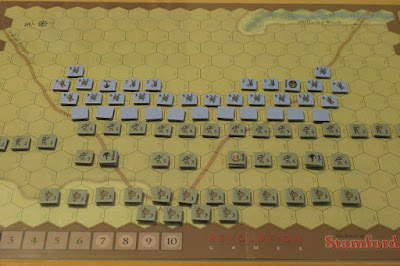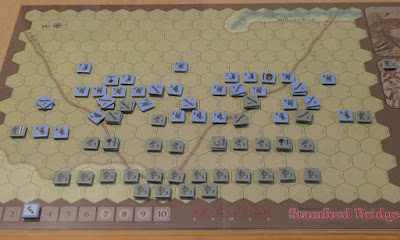The Battle of Stamford Bridge 1066.
King Harold marches his Anglo-Saxon army north to meet with Viking invader, King Hardrada.
The game is my own design and was published, together with a Hastings game by Revolution Games in 2015.
Last year both games went out of print. I am pleased to say that Legion Games are looking at bringing both games back, but to also include the remaining battle of that year as a new design … Gate Fulford, which has been designed by Geoff Noble, who is also doing a strategic 1066 game for Legion Games. The idea is that the strategic game and the individual battles will form a complementary 1066 line-up
All three battles will be packaged together and share the same game engine. I have seen the proposed artwork, which looks very nice, so fingers crossed on all of that.
In the meantime, today, I am putting my copy of the Revolution Games’ Stamford Bridge to the table.
Please use the ‘read more’ tab for the rest of this post.
Despite sharing the same game engine, Hastings and Stamford Bridge give very different play experiences. Hastings is a slow grinding game as the Normans fight hard to gain the Senlac Ridge. It was an eight hour battle.
Stamford Bridge by contrast is a brutal hack and slash game and after playing the Hastings game, the speed at which casualties rack up can be quite shocking.
At the heart of the game is the class / morale system. As casualties mount amongst the various unit types, there becomes an increasing chance that the further loss of individual units will cause those around them to rout.
At first this happens just here and there as individual groups break, but as the situation deteriorates, larger groups will run, until whole sections of line can break, with reserves, usually of a lower quality, desperately trying to shore up the gaps as the battle tips towards one side or the other.
Anyway, here we are. One of the aspects about Stamford Bridge is that the Vikings were quite unprepared for battle. Many men had left their armour on the ships back at Riccall and a significant part of the army was also there under Orri's command.
This will give us two things to consider in the battle. Firstly to represent the armour left back at the ship, the Viking front line is drawn from a pool of mixed combat values and set up with the counters face down so that neither side knows the strength of each unit.
Some units will have their armour and be at strength 5 and others will not, being at strength 4. The true value of a unit is not revealed until the moment of combat has been declared.
Secondly, Orri's reinforcement ran all the way from Riccall and arrived pretty much exhausted. In this game, exhausted troops cannot attempt recovery from disorder or rout, so they can be a one shot party trick.
Also note, units fight one on one, the system does not allow ganging up.
The Refight.
Above, this is a fixed set-up (unless options are used). Note the front line of Viking counters (blue) are face down, these are the units that may or may not have their armour.
There are strict movement restrictions on turn 1, to represent the fact that Harold has had to deploy his force on the other side of a narrow bridge and the Vikings are steadfastly in their shield wall formation.
As the first line of housecarls throw themselves at the Viking shield wall, they manage to break into the Viking line at a couple of points, but suffer heavily from disorder results.
Above - by the Start of turn three, we have the typical chaos of this game as the lines mix and individual unit flanks become exposed and vulnerable to quick defeat.
The housecarls are taking very heavy casualties, though the Viking shield wall has lost much of its cohesion. Harold's troops had pushed their archers out to the flanks, but the Viking levy extended the Viking front to meet that threat and inflicted heavy losses on the bowmen.
Above - the first rout of the game sees a unit of housecarls break. For a unit to rout, a side must already have suffered a lot of casualties. Thereafter, whenever a unit is removed from play, that side rolls a D6 for each unit class adjacent to the lost unit (i.e. the housecarls or the fyrd).
The die roll is added to the number of casualties suffered so far by that class and if the total exceeds the unit type break level, then each adjacent unit of that class routs, so obviously the more losses a side takes, a lower die roll will be enough to cause adjacent units to rout and something of an escalation follows.
The Vikings have an incredibly lucky round of re-ordering disordered units, while Harold's troops continue to take losses.
Above - it is the end of turn 5 and the Orri reinforcements have just started to arrive, crossing Millsike Beck at a ford (top right of the map).
Harold's army is on its knees! Harold himself is exposed and needs to move. I can't remember seeing the Saxons losing this badly so early in the game before.
At turn 7, the Orri reinforcement automatically reaches exhaustion, so any of those units that now go disordered or rout .... stay that way. However, the reinforcement does have one opportunity to launch an attack with their hirdmenn using 'Berserker Rage', getting an uplift on their attack dice.
This is to represent the shock wave that historically hit Harold's line, when Orri arrived (known as Orri's storm), almost crushing the Anglo-Saxon position.
The Saxon army is fighting for its life, their leaders join in the fray, encouraging more from the men - they should have done this earlier!
Above - Harold has a narrow escape as the fyrd unit he is with is swept away. The writing is well and truly on the wall as Viking units press towards the road junction. Taking this would cut Harold off from the bridge.
Then .... Harold's brother, Gyrth, falls when those with him are attacked in the flank and this sets the final scene for a complete and massive Anglo-Saxon defeat!
Conclusion
Well the unravelling actually began on turns 2 and 3. The losses to the Housecarl were so great that further loss was almost certain to create routs, causing the army to deteriorate quickly.
They should have been less reckless and not simply charged at everything in front of them, concentrating instead on weakened areas of line and supporting any success with fresh attacks and keeping some of the front line ‘fresh’ as an immediate reserve for the following turn.
The early loss of archers fed into the break level of the fyrd, so that their break level was too quickly reached early in the game.
I have put a link in the resource section below that covers an earlier game in much more detail, with more of the game engine explained and which played out to a much closer ending.
As always, thanks for reading this far.
Resource Section.
An earlier replay of the game, LINK
https://battlefieldswarriors.blogspot.com/2016/04/invasion-1066-stamford-bridge.html
My sister webspace ‘COMMANDERS’ showcases the various figure and boardgame systems that I am enjoying and gives a flavour of where current projects are up to. Link.






